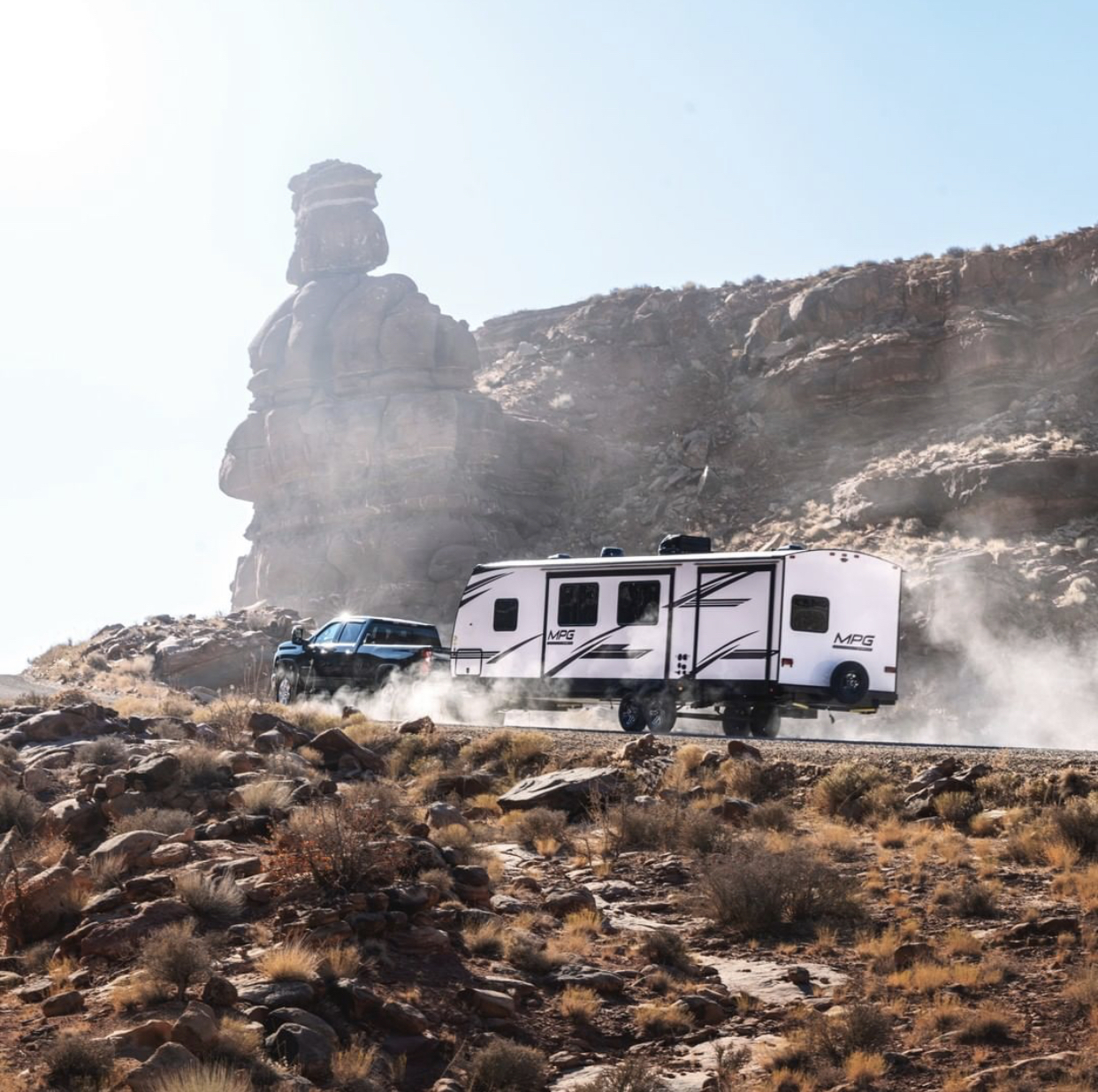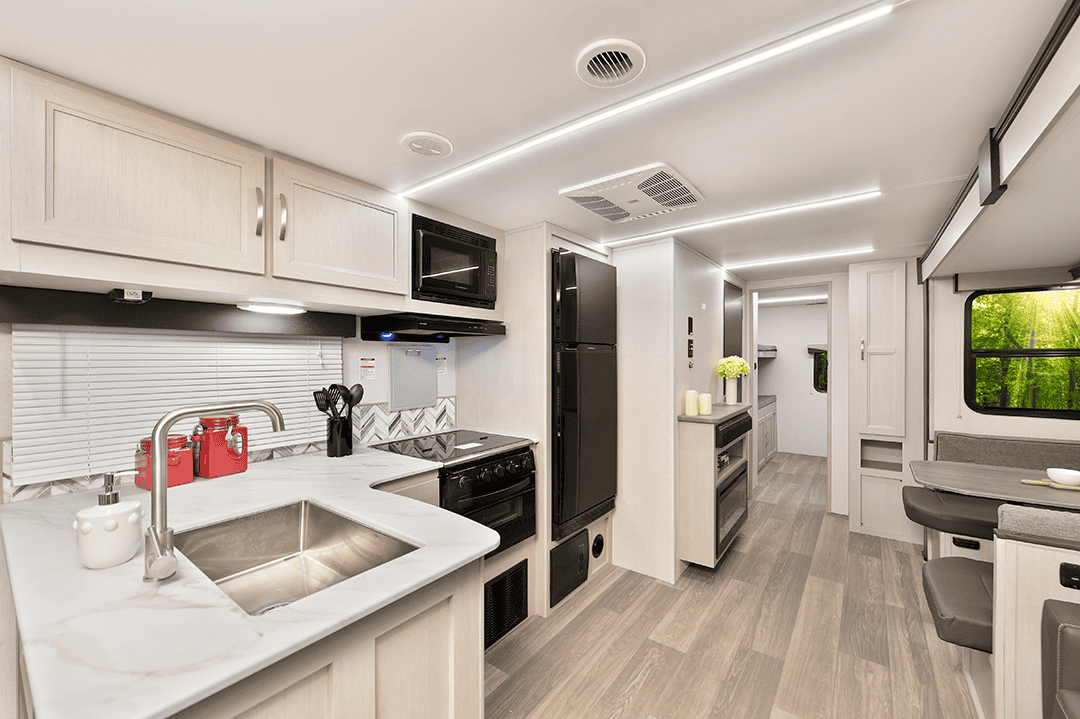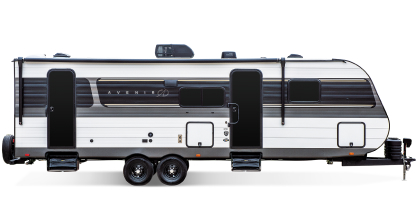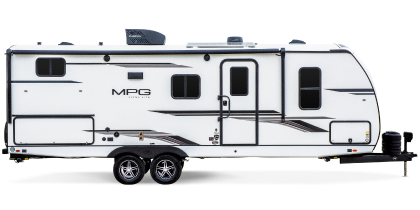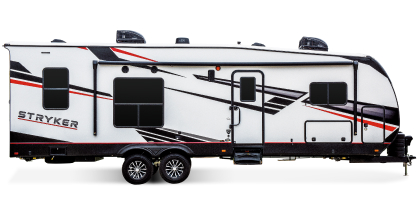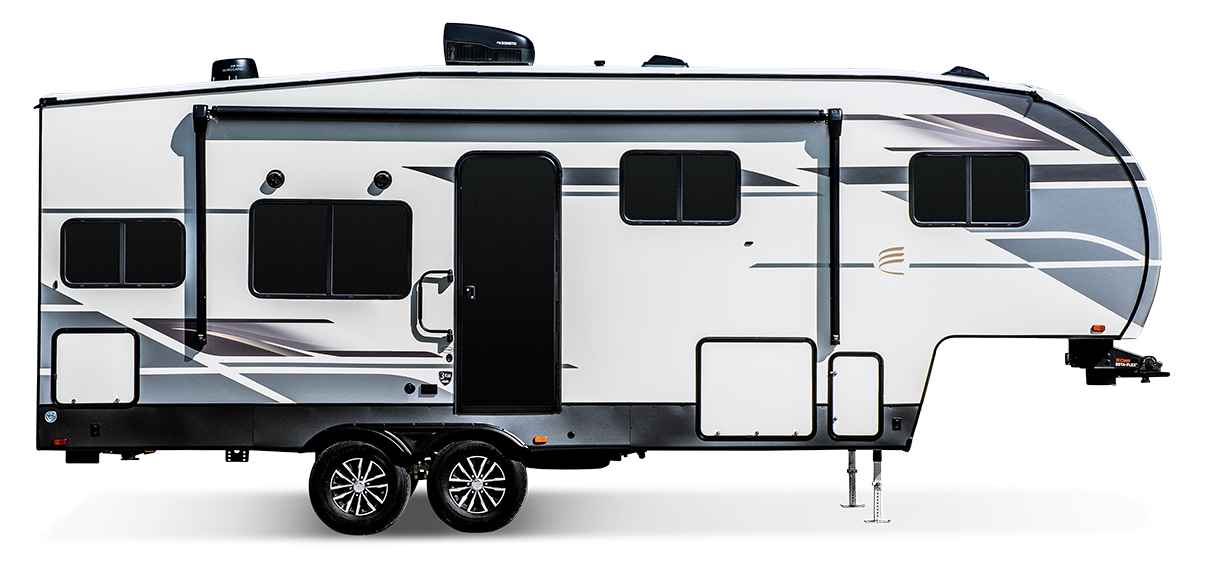When you’re looking into buying your first RV, it can be overwhelming. So it’s best to start with the basics and work up from there.
TYPES OF RVS
First things first––there are several different types of RVs, including:
- Travel Trailers
- Fifth Wheels
- Toy Haulers
- Class A RVs
- Class B RVs
- Class C RVs
TOWABLE RVS
Travel Trailers are any RVs pulled by a tow vehicle like a truck or SUV. While the slang name for a travel trailer is a “bumper pull,” these RVs require a hitch that’s bolted to the tow vehicle. Smaller trailers can be towed by some SUVs and vans and most trucks. Larger travel trailers may require a higher capacity truck.
Fifth Wheels are a type of travel trailer with a specialized hitch for easier towing. Fifth wheels require heavy duty trucks with the hitch installed in the truck bed. This creates more stable towing due to the weight centered over the back of the tow vehicle. Fifth wheels are longer and taller than other trailers, but handle more easily with less sway than other trailers.

Toy Haulers are another style of travel trailer. They have a separate garage space at the back of the trailer designed for motorized vehicles, like motorcycles, ATVs, dirt bikes, etc. The back opens into a ramp for loading toys, or into a back patio for additional space. Some toy haulers even have an extra side patio to really maximize the floor plan. Toy hauler models come in both standard trailer and fifth wheel configurations.
MOTORIZED RVS
Class A RVs are the biggest of the motorized RVs, often built on a commercial bus or truck chassis. For instance, a stereotypical tour bus resembles a Class A. Like all categories of trailers, Class A RVs can feature slide outs, parts of the RV that expand when parked to provide more living space. They are often capable of towing other vehicles behind them.
Next, Class B RVs are typically built on a modified van chassis. They are the smallest of the motorized RVs, limited to the footprint of a commercial van size. But they still can contain a bedroom, a kitchen and a small bathroom. They’re easy to park and get the best gas mileage of all the motorized RVs.
Class C RVs are built on a heavy-duty truck chassis and their size fits somewhere between Class A and Class B RVs. They are often identifiable by their overcab sleeping areas. Like a Class A, a Class C RV may be able to tow another vehicle, and they may also use slide outs to maximize the living area.
CHOOSING THE RIGHT RV
Choosing what kind of RV to buy comes down to a few main factors:
- Cost
- Number of beds
- Motorized vs. towable RV
- Your towing capacity
- How you intend to use it
Other factors might help you refine your choice, such as whether or not you’ll be boondocking, the climate of where you intend to camp, your comfort level driving a big rig, etc. But with the four questions above, you can start narrowing it down significantly. Because all RVs offer models in a variety of sizes and sleeping capacities, we’ll focus on the other factors.
THINGS TO CONSIDER
COST
Like any major purchase, your budget will drive what kind of RV fits your lifestyle. With so many different styles of RV, prices run the gamut. You’ll find relatively inexpensive tiny travel trailers to large and luxurious Class As. Even within segments, there are floor plans and upgrade packages to fit everything you’re looking for, whether you want something minimal and value-driven or packed with high-tech features and opulent touches. Because most RV manufacturers don’t sell directly to consumers, always confirm the final prices of any unit you’re researching with your preferred dealer.
MOTORIZED RVS
- Class A RVs start on the low end at $50,000 and can go up to millions of dollars for top-of-the-line, luxury models.
- Most Class B RVs range from $40,000 to $80,000 for basic models, and can cost six figures for more custom configurations or high-end details.
- Midsize Class C RVs average between $50,000 and $100,000, but can include more expensive models from luxury manufacturers.
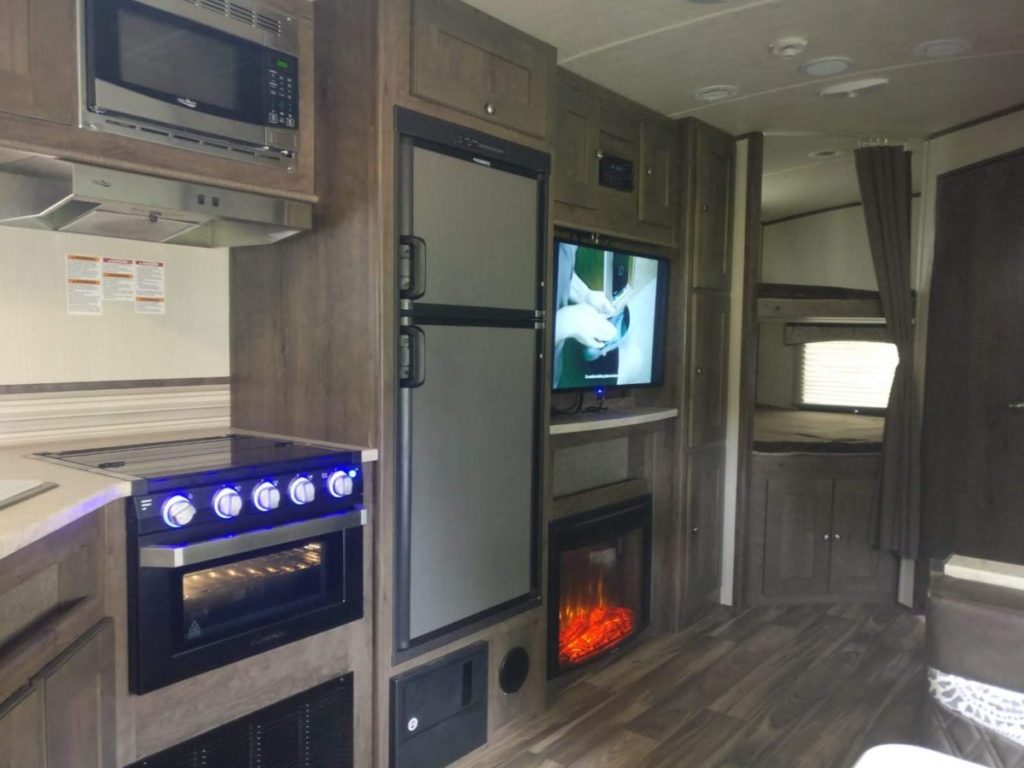
TOWABLE RVS
- In general, towables offer more affordable options because of the wider variety of sizes.
- Small travel trailers can be found for as low as $8,000, but average around $20,000.
- An average, standard sized travel trailer will run you around $35,000.
- Toy haulers and fifth wheels tend to be a little more expensive due to the features they offer. Toy haulers start around $40,000 and fifth wheels average $75,000 to $100,000, brand new.
- And with hundreds of floor plans and packages, you can find travel trailers that range from minimal and streamlined to those with luxury amenities.
UNDERSTANDING TRAILERS AND TOW VEHICLES
If you’re researching travel trailers, two of the biggest considerations are the trailer weight and your towing power. As you begin researching, you have two options. You can look for a trailer light enough to tow with a vehicle you currently own. Or you can plan on purchasing a new SUV or truck that has a higher towing capacity.
While you need to know the weight of the travel trailer itself, also keep in mind the cargo. Everything that goes into the trailer and tow vehicle needs to be factored into the towing equation. That includes the weight of full onboard tanks of water and gas, the weight of all the cargo you plan to bring with you, and even the weight of every passenger you’ll carry in the tow vehicle. Most RV specs list dry or unloaded weight. So you’ll need to take into account the weight of tanks, batteries or cargo.
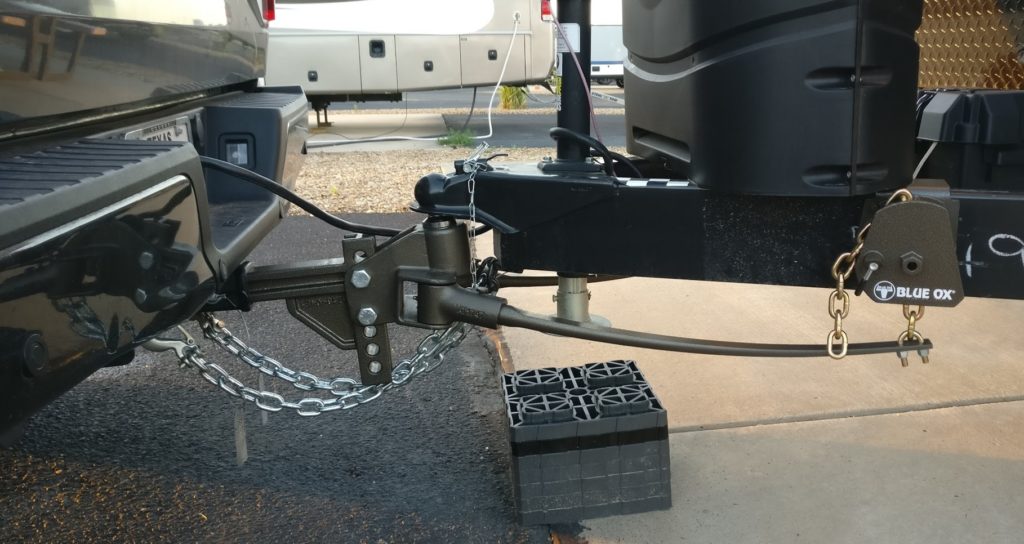
TOW VEHICLES
You need the right tow vehicle to match a trailer. If you buy anything other than a small trailer, you’re venturing firmly into truck territory.
Trucks are classified by their power and capacity, and these classifications go by a few different names. You may know them as “light duty,” “medium duty” and “heavy duty” trucks, as outlined by the Federal Highway Administration. While each truck classification has different towing capacities, they all provide similar vehicle features and serve as a preferred tow vehicle option––if you’re choosing to tow using a semi truck or tractor trailer, you would be required to have a commercial license.
Some people might also refer to truck classifications in tons: half ton, three-quarter ton, and one ton trucks. These names no longer refer to the actual capacity of a truck, as payload capacity has gone up over time while the names remained the same. But it’s useful to know these terms that people still throw around in conversation.
Trucks are classified into this system by their gross vehicle weight rating (GVWR). This just means the total weight a truck can move. It includes both the weight of the truck itself and anything inside. For instance, the weight of fuel, the driver, all passengers and any accessories. GVWR does not measure how much weight a truck can tow, just a truck’s general capacity.

BEST SELLING TOW VEHICLES
Here are some of the best-selling trucks in the US and their capacity classifications:
- Light duty/half-ton: Ford F-150, Chevrolet Silverado 1500, GMC Sierra 1500, RAM 1500, Toyota Tundra, Nissan Titan
- Medium duty/three-quarter ton: RAM 2500, Ford F-250, Chevrolet Silverado 2500, GMC Sierra 2500
- Heavy duty / one ton: RAM 3500, Ford F-350, Chevrolet Silverado 3500, GMC Sierra 3500
Our 33-foot travel trailer has a weight of 7,500lbs fully loaded. And our Ford F150 with the max tow package does the towing. If you wanted to tow a 44-foot, triple-axle toy hauler that hit 20,000lbs when fully loaded, you would want a heavier duty one-ton truck like a Ram 3500 or F350 or equivalent. (Fun fact: heavier duty trucks with dual rear wheels are sometimes called “duallys.”)
CALCULATE TOWING CAPACITY
There are many handy calculators online that allow you to plug in a tow vehicle to find out how much weight it can tow. Just keep in mind that the weight will need to include the weight of the RV and everything inside it. Don’t leave out full tanks of water, propane and waste tanks, cargo, accessories, tools and any toys you bring along for the ride.
WHAT THE HECK IS A TOAD?
A toad is the opposite of a tow vehicle––a vehicle that gets “towed” behind a motorized RV. (Get it? Towed = Toad.) Most people who opt for Class As or larger Class Cs bring a toad car. Toads are also referred to as dinghys. They’re useful for getting around town without having to pack up and move your RV every time you need to hit the grocery store. Toads range from cars up to crossovers and smaller SUVs. For instance, the Jeep Wrangler proves a popular choice for people who love off-roading. More laid back campers might go for a compact car they use for sightseeing.
INTENDED USE
How you intend to use your RV will also help narrow down your options. For example, do you plan on camping a few weekends out of the year? Or will you live in your RV for all or part of the year, like snowbirds do? If you’re a “full-timer,” choosing an RV with the amenities of home and a warranty that covers full-time RVing might be most important. If you’re a “sometimer,” you might prioritize value.

QUESTIONS TO ASK YOURSELF
When you camp, do you like having all the comforts of home? Or do you enjoy going off-grid and roughing it? (Maybe both?) Class A RVs are huge and can come in really luxurious configurations. You’ll find gourmet kitchens, full-size bathrooms and slide-outs that offer maximum room to spread out. But if you like camping off-grid, a Class A may be too unwieldy to reach remote boondocking sites, and a full-size fridge can zap a lot of power. So you may be better off prioritizing a unit that has big water tanks and onboard generators over cushier details.
Finally, are you the kind of person looking to hit the road with your ATV, motorcycle, golf cart or other big, non-motorized toys like kayaks or canoes? A toy hauler has a ramp off the back that makes loading and unloading gear easy and quick. But lots of bigger families also love toy haulers because the garage space can be converted into an all-purpose room. We’ve seen the garage used as an extra bedroom, a playroom, a classroom, an office, even a gym. Toy haulers are a bit more expensive but supremely flexible for people looking to get creative.
SIZE
Finally, size can play a big role in choosing your RV. Many people want a smaller RV or travel trailer because they’re easier to tow and park. They can also be more nimble in rougher terrains, such as on unpaved roads or boondock campsites. However, the special hitch on a fifth wheel can help mitigate some of the intimidation of towing a larger trailer, and lots of people choose to upgrade to a larger size once they’ve been RVing for a while.
This should be enough information to get you started researching RVs. We’ll be back soon with a Part 2 that goes into more detail on some of the finer points of shopping for your first RV––including what questions to ask at the dealership.
Disclaimer: Max towing varies based on cargo, vehicle configuration, accessories, and number of passengers. See owner’s manual for all vehicles and accessories before towing.
